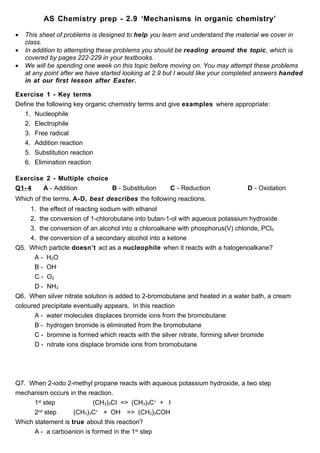
As Chemistry Prep 2 9 Mechanisms
- 1. AS Chemistry prep - 2.9 ‘Mechanisms in organic chemistry’ • This sheet of problems is designed to help you learn and understand the material we cover in class. • In addition to attempting these problems you should be reading around the topic, which is covered by pages 222-229 in your textbooks. • We will be spending one week on this topic before moving on. You may attempt these problems at any point after we have started looking at 2.9 but I would like your completed answers handed in at our first lesson after Easter. Exercise 1 - Key terms Define the following key organic chemistry terms and give examples where appropriate: 1. Nucleophile 2. Electrophile 3. Free radical 4. Addition reaction 5. Substitution reaction 6. Elimination reaction Exercise 2 - Multiple choice Q1- 4 A - Addition B - Substitution C - Reduction D - Oxidation Which of the terms, A-D, best describes the following reactions. 1. the effect of reacting sodium with ethanol 2. the conversion of 1-chlorobutane into butan-1-ol with aqueous potassium hydroxide 3. the conversion of an alcohol into a chloroalkane with phosphorus(V) chloride, PCl5 4. the conversion of a secondary alcohol into a ketone Q5. Which particle doesn’t act as a nucleophile when it reacts with a halogenoalkane? A - H2O B - OH- C - O2 D - NH3 Q6. When silver nitrate solution is added to 2-bromobutane and heated in a water bath, a cream coloured precipitate eventually appears. In this reaction A - water molecules displaces bromide ions from the bromobutane B - hydrogen bromide is eliminated from the bromobutane C - bromine is formed which reacts with the silver nitrate, forming silver bromide D - nitrate ions displace bromide ions from bromobutane Q7. When 2-iodo 2-methyl propane reacts with aqueous potassium hydroxide, a two step mechanism occurs in the reaction. 1st step (CH3)3CI => (CH3)3C+ + I- 2nd step (CH3)3C+ + OH- => (CH3)3COH Which statement is true about this reaction? A - a carboanion is formed in the 1st step
- 2. B - heterolytic fission occurs in the 1st step C - the overall reaction involves electrophilic substitution D - the overall reaction involves free radical substitution Q8. CFC’s have been widely used as refrigerants and during the disposal of refrigerators, are released into the atmosphere. CFC’s are no longer used because A - they are very poisonous B - they damage the ozone layer C - they make rain water acidic D - they are ‘greenhouse gases’ Q9- 11 . Equations related to the formation and destruction of ozone in the upper atmosphere are shown. A- O2 + uv = Oo + Oo B- Oo + O2 = O3 C- O3 + uv = O2 + Oo D- Clo + O3 = O2 + ClOo Which equation 9. represents an initiation reaction for the formation of ozone? 10. shows how ozone reduces the amount of uv radiation that reaches the earth’s surface? 11. shows how free radicals from refrigerants can reduce ozone levels? Exercise 3 - Questions from the textbook Attempt the following questions: Questions 1 and 2 on page 223 Questions 1-3 on page 225 Question 1 on page 227 Remember you can always ask for help from EBG or myself, you can even email me mfe@slcuk.com MFE